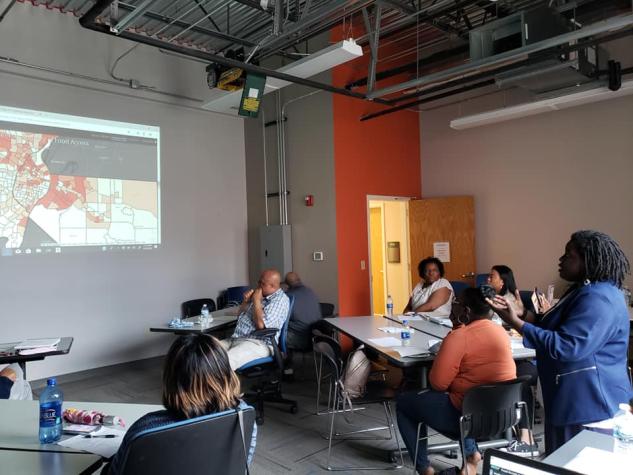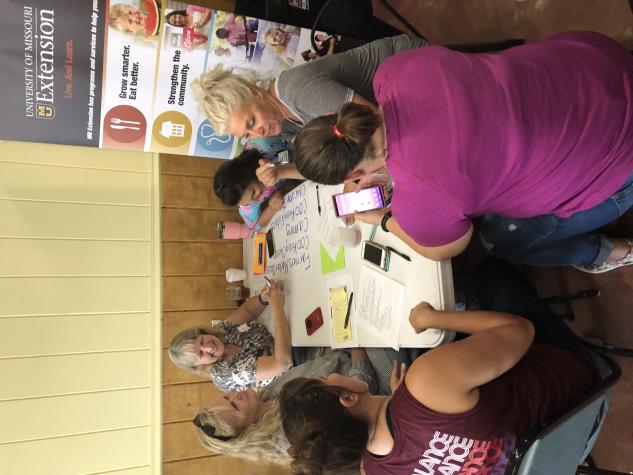Erica Williams, founder of a nonprofit urban agriculture program in North St. Louis County, had a vision of how to reclaim a community that had suffered through disinvestment and neglect.
Across the state in Clay County, Smithville’s mayor hoped amenities like a farmers market would help reinvigorate the small city 20 miles north of Kansas City.
In rural Pulaski and Moniteau counties, community stakeholders are figuring out how to strengthen local food systems to help revive their flagging economies.
What knits these four projects together is a University of Missouri Extension program called Missouri EATs, short for Engage, Act, Transform. Part of MU Extension’s Community Economic Development program, Missouri EATs offers a framework to help build stronger communities through healthy, resilient and equitable community-based food systems.
“Missouri EATs starts with facilitated discussions with community members about what’s most important to them about local food issues,” said Bill McKelvey, Missouri EATs project coordinator. “People from all parts of the community come together around issues as diverse yet connected as hunger relief, nutrition and health, local farming, creating markets for local producers and helping more young people stay in a community and make a living off the land.”
North St. Louis County, Smithville and Pulaski and Moniteau counties are the first of six Missouri communities to participate in the pilot adapted from the Oregon Food Bank’s Food, Education, Agriculture, Solutions, Together (FEAST) program. Once MU Extension’s adaptation is tested and refined, the model will be available to faculty across the state.
With programs in all 114 counties and the City of St. Louis, McKelvey said, MU Extension is well positioned to support initial planning and assist with projects such as startup urban agriculture centers, farmers markets and community gardens; helping communities apply for grants; coordinating emergency food services and initiating nutrition education programs.
In Pulaski County, MU Extension specialist Cathy Galland is working with producers and interested community members on a regional approach to branding and marketing local foods. Missouri EATs Dixon Community Conversations partners include the county health department, A Mustard Seed Community Development Corp., Naturally Meramec and Dixon Elementary School.
“Like most rural, agricultural-based counties in Missouri, Pulaski faces its share of challenges with local food systems and businesses,” Galland said. “Through these conversations, the community decides what is most important to address these challenges.”
One outgrowth has been the formation of a nonprofit group that is working to start a farmers market in Dixon. The group has also purchased a building, where it intends to develop a commercial kitchen, and with other partners, is looking at developing a regional food hub.
Missouri EATs has partnered with the Moniteau County Neighbors Alliance for a series of community conversations around food production. The first conversation, designed to serve as inspiration for what might be possible in participants’ own communities, will look at the Columbia Center for Urban Agriculture’s Planting for the Pantry project, which donated 20,000 pounds of food to people in need, and a veterans’ farm project that is creating a healthy and healing therapeutic environment.
Missouri EATs brings diverse people and interests together at the same table. The Smithville and North St. Louis projects show how Missouri EATs can be a catalyst for groups to coordinate efforts and activities, McKelvey said.
“Oftentimes, you’ll have multiple groups or leaders in the community coming up with many different ideas, but they are all happening in isolation from each other,” said GK Callahan, an MU Extension community economic development specialist in Clay County. “They may duplicate efforts or miss important chances to coordinate that would strengthen the overall impact.” Missouri EATs’ greatest strength, he said, is “helping folks connect the dots to assess feasibility, form partnerships and coordinate next steps.”
In St. Louis County, “we wanted to see what was possible using this Missouri EATs program as a planning tool in a more urban setting,” said Dwayne T. James, county engagement specialist in community economic development with MU Extension. There was clearly a hunger and need for redevelopment: A well-attended Missouri EATs event in Pine Lawn, Mo., led to leadership from A Red Circle to develop the North County Agricultural Education Center. (Related story: Growing a food hub and community at the same time.)
“Whether a community is looking for ways to make sure people have the resources they need to access healthy food — such as a grocery store or community garden, or they are thinking more broadly about developing sustainable food systems, our hope is that some really successful projects come out of these Missouri EATs sessions,” McKelvey said. “These issues connect to, and can address, long-standing issues of community health and resilience, too.”
Photos available:
Tosha Phonix speaking
Tosha Phonix of Missouri Coalition for the Environment speaks about food security in the region at a Missouri EATs listening session in 2019.
Smithville participants
At a 2019 Missouri EATs session, Smithville participants brainstorm ways food-related activities and businesses can encourage local economic development.
Writer: Katherine Foran

